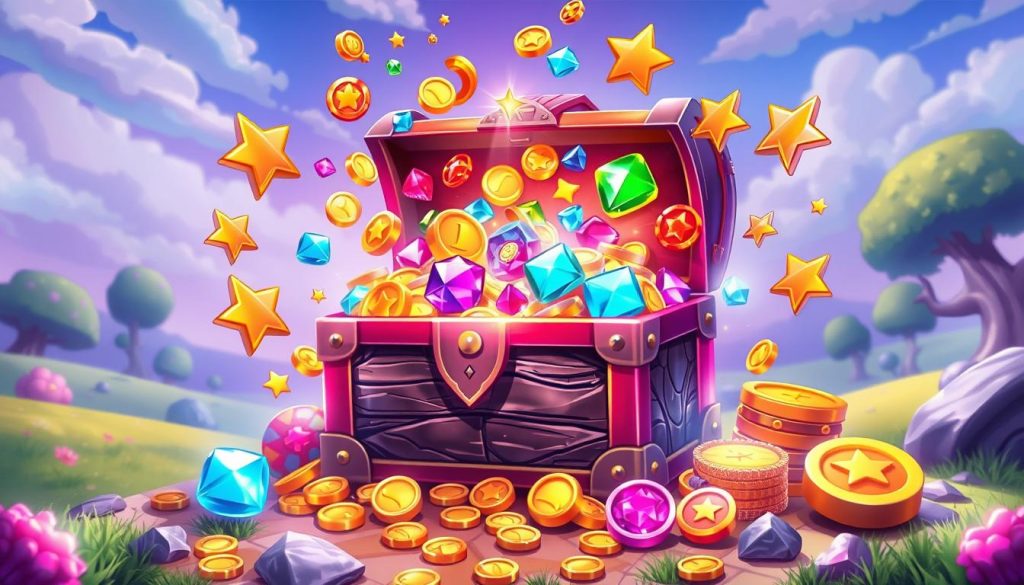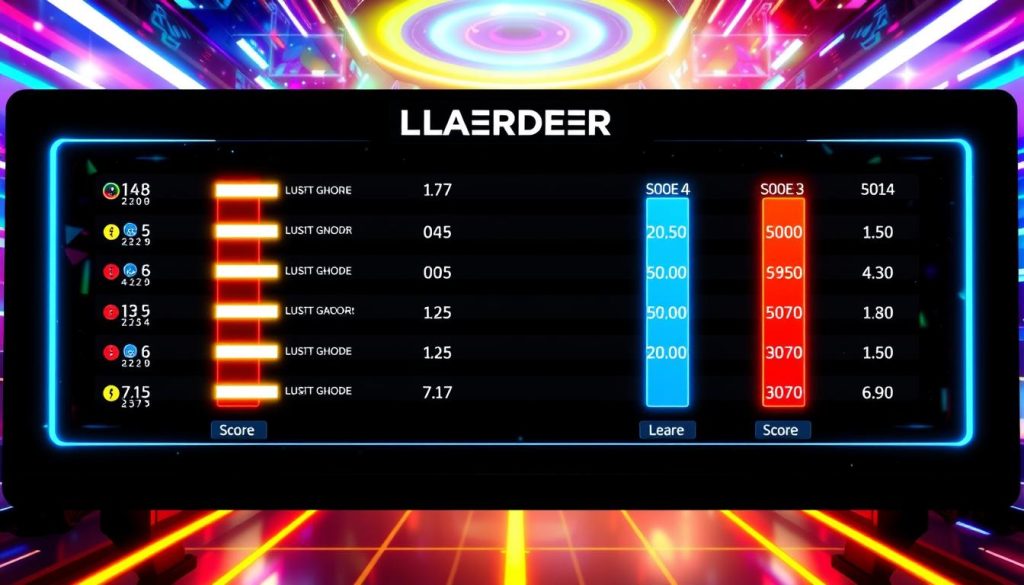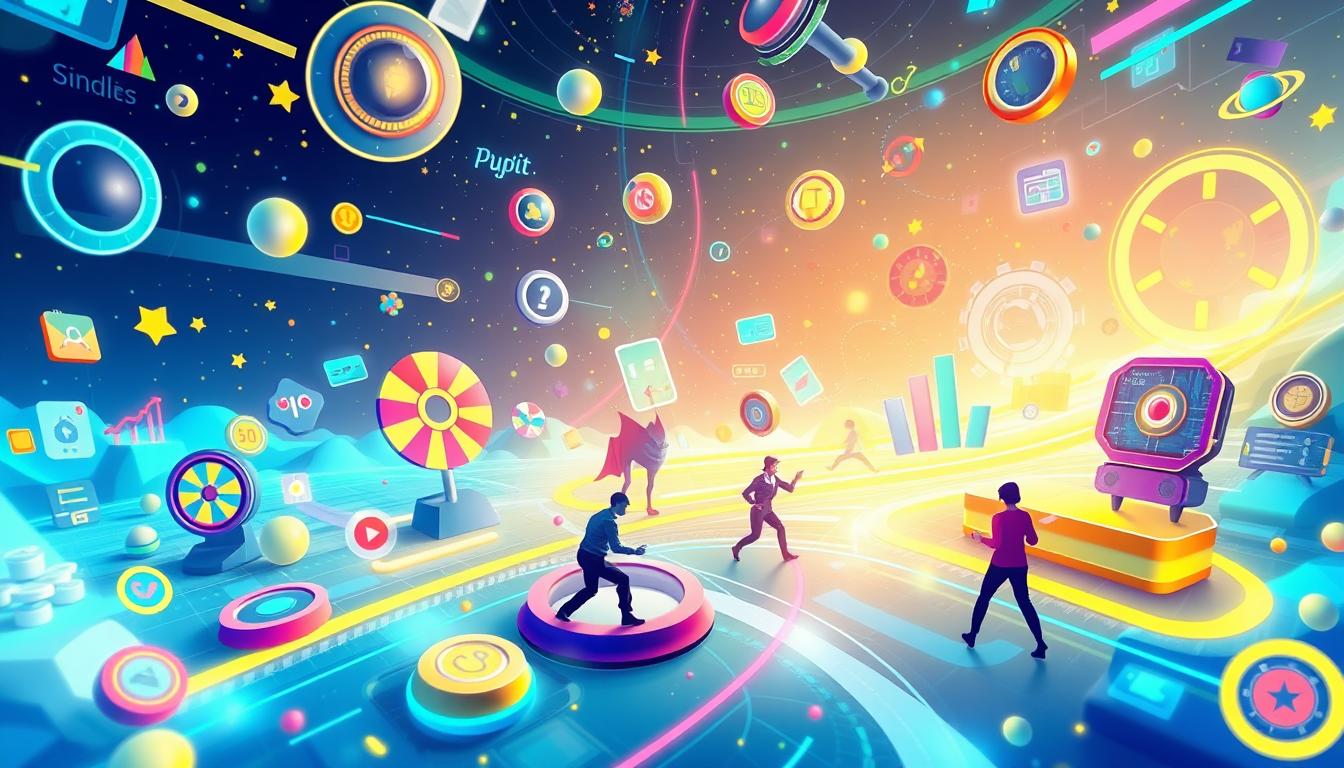In today’s competitive business world, companies are always looking for new ways to get leads and engage their audience. One effective strategy is gamification. It uses game-like elements in non-game settings to boost user engagement, build brand loyalty, and get valuable leads.
Key Takeaways
- Gamification uses game-like elements to improve user engagement and lead generation
- Interactive content, rewards, and competitive features can grab audience attention
- Tracking user progress and encouraging social sharing makes gamification more effective
- Well-designed gamification strategies can greatly increase lead capture and conversion rates
- It’s important to measure the success of gamification campaigns with key performance indicators
What is Gamification?
Gamification uses game-like elements to make non-game activities fun and engaging. It adds points, leaderboards, badges, and challenges to make experiences more enjoyable. This approach boosts user interaction, loyalty, and brand connection.
Definition and Key Concepts
Gamification takes the fun of games and applies it to everyday life. It rewards users for actions, creates competition with leaderboards, and gives badges for achievements. This makes experiences more rewarding and interactive.
Benefits of Gamification for Businesses
Businesses gain a lot from gamification. Here are some key benefits:
- Increased User Engagement: Gamification makes experiences more fun and interactive. This leads to more time spent and higher engagement.
- Improved Customer Loyalty: It creates a rewarding experience that builds strong emotional bonds. This leads to more loyalty and repeat business.
- Stronger Brand Affinity: Gamification makes a brand stand out. It offers a unique experience that strengthens brand recognition and loyalty.
Gamification is a powerful tool for businesses. It boosts user engagement, loyalty, and brand strength in the market.
Lead Generation Through Gamification
Gamification is a strong tool for businesses wanting to get valuable leads and engage their audience. It adds game-like elements to marketing, making it fun for users to share their contact info and data.
One big plus of gamification for lead generation is getting user data easily. Users are more likely to give out their email or phone number for rewards or to move forward in the game.
Also, gamification helps build stronger user connections and loyalty. It makes experiences more engaging, so users spend more time on the platform. This can lead to more leads and repeat business.
| Gamification Tactic | Potential Benefits |
|---|---|
| Interactive Quizzes and Surveys | Gather user preferences, interests, and contact information |
| Scavenger Hunts and Challenges | Incentivize user engagement and data collection |
| Virtual Rewards and Badges | Motivate users to share their personal information |
By using gamification, businesses can make their lead generation better. They create fun, interactive experiences that get user data and build lasting connections with their audience.
Interactive Content and Game-like Experiences
In the world of content marketing, interactivity and game-like experiences are key. They help grab users’ attention and keep them engaged. Gamification, using game elements in non-gaming areas, boosts user engagement and lead generation.
Examples and Best Practices
Interactive quizzes, surveys, and simulations are great examples. They let users take part and get results tailored to them. These experiences meet our need for challenge and achievement, leading to more engagement and leads.
- Interactive product configurators that let users customize and visualize their ideal solution.
- Branded mini-games that educate and entertain users while promoting a company’s products or services.
- Gamified assessments and benchmarking tools that provide personalized insights and recommendations.
When using interactive content, focus on giving real value to users. The content should be relevant, informative, and fun. It should also fit the brand’s message well. This way, businesses can attract leads and keep users engaged over time.
“Gamification is not about making everything a game. It’s about using game-like elements to drive specific behaviors and achieve desired outcomes.”
| Gamification Examples | Key Benefits |
|---|---|
| Interactive product configurators | Increased user engagement, personalized solutions, higher conversion rates |
| Branded mini-games | Enhanced brand awareness, educational content delivery, improved user experience |
| Gamified assessments and benchmarking tools | Personalized insights, lead generation, thought leadership positioning |
By adding interactive content and game-like experiences to their content marketing plans, businesses can tap into gamification’s power. This helps capture leads, boost user engagement, and reach growth goals.
Rewards and Incentives for User Engagement
Gamification uses rewards and incentives to boost user engagement and loyalty. Businesses can encourage customers to take part in their offerings with effective reward systems. This motivates users to complete actions they want to do.
Loyalty programs are a key gamification technique. They reward users for staying engaged, offering points, badges, or virtual goods for tasks or milestones. These rewards can be traded for discounts, exclusive content, or other benefits, making users feel accomplished.
Point systems are another strategy. Users earn points for activities like buying things, sharing on social media, or finishing challenges. These points unlock extra features, exclusive content, or physical rewards, encouraging more engagement and loyalty.
| Reward Type | Benefits | Examples |
|---|---|---|
| Loyalty Programs | Encourage repeat business, foster customer retention, and drive long-term engagement. | Airline miles, credit card reward points, and brand-specific loyalty programs. |
| Point Systems | Motivate users to complete specific actions, track and measure user engagement, and offer tangible rewards. | Reward points for purchases, social media shares, and completing challenges. |
By designing and using these reward-based strategies, businesses can engage users better. This increases loyalty and drives behaviors that help grow the business.

Gamification Strategies to Capture Leads and Engage Users
Gamification can change the game in lead capture and user engagement. It adds interactive, game-like elements to your marketing. This makes the customer experience more immersive and rewarding.
Offering personalized challenges or quizzes is a great strategy. Users can earn points, badges, or rewards. This grabs their attention and encourages them to engage with your brand. It leads to more leads and loyal customers.
Using data to personalize the gaming experience is key. Analyze user behavior and preferences to tailor the game. This means customized rewards, leaderboards, and content recommendations for each user.
To boost engagement, add social features to your gamification. Let users compete with friends, share achievements, and get referral bonuses. This builds a community and drives growth.
“Gamification is not just about adding points and badges – it’s about creating an engaging and rewarding experience that keeps users coming back.”
Keep improving your gamification strategies to create a captivating experience. This not only captures leads but also builds long-term engagement and loyalty.
Competitive Elements and Leaderboards
Gamification can really grab users’ attention and keep them coming back. It uses competition and leaderboards to tap into our natural drive to do better. This way, businesses can create a fun, competitive atmosphere among their audience.
Fostering Healthy Competition
Leaderboards are a key tool in gamification. They let users see how they stack up against others. When done right, they push users to aim higher, boosting participation and engagement.
But, it’s important to keep competition healthy and positive. Businesses should aim for a supportive vibe where users want to get better, not just beat others.
By adding social proof and user engagement, gamification can use competition to get users to act in certain ways. This can help build loyalty and drive sales.
| Competitive Element | Benefit |
|---|---|
| Leaderboards | Showcase top performers, motivate users to improve their ranking |
| Challenges and Achievements | Provide a sense of accomplishment, encourage users to set and reach goals |
| Progress Tracking | Allow users to visualize their growth and advancement |
By using competitive elements and leaderboards wisely, businesses can create a healthy competition. This drives user engagement and can lead to more sales and success.

Progress Tracking and Achievement Badges
In the world of gamification, tracking progress and giving out achievement badges are key. They help keep users engaged, boost motivation, and help with goal-setting. By showing users how far they’ve come, businesses can make their products seem more valuable. This encourages users to keep going.
Achievement badges are like digital trophies that celebrate users’ achievements. They make users feel proud of what they’ve done. They also push users to do more and get more involved with the brand.
Using progress tracking and achievement badges well can really change how users act. It can make them more likely to set goals and stay motivated. This can lead to more people buying from the brand and a more loyal customer base.
“Gamification can be a powerful tool for businesses, as it taps into our innate desire for progress, achievement, and recognition. By incorporating these elements into the customer experience, brands can foster a deeper level of engagement and loyalty.”
To get the most out of progress tracking and achievement badges, businesses need to plan them well. They should match these strategies with their marketing and customer goals. This way, they can make a more fun and rewarding experience for their customers. This can help grow their business and get more leads.
Social Sharing and Referral Incentives
In the digital marketing world, using social networks can change the game for businesses. They can get more leads and engage users better. By adding social sharing and referral incentives to their strategies, companies can use word-of-mouth marketing. This makes the user experience more dynamic and collaborative.
Leveraging Social Networks
Social media is a big part of our lives today. It gives businesses a chance to reach more people and build a community around their brand. By letting users share their experiences and achievements, companies can get more leads and engage users more.
Offering rewards for sharing can make users promote your brand to their friends. This increases your reach and builds trust. People trust recommendations from friends more than ads.
| Social Sharing Strategies | Referral Incentives |
|---|---|
|
|
By using social networks and offering referral incentives, businesses can make the most of user content and word-of-mouth. This approach helps generate leads and engage users in a natural and lasting way.
Gamification Best Practices
Creating successful gamification strategies means focusing on key practices. These include prioritizing user experience, using data to guide decisions, and making experiences personal and scalable. By doing this, businesses can fully tap into gamification’s potential. They can also engage their audience in meaningful ways.
Deliver a Seamless User Experience
The heart of a good gamification strategy is a design that puts the user first. It should blend game elements smoothly into the customer’s journey. This means making interfaces easy to use, setting clear goals, and giving instant feedback and rewards. These actions help users feel a sense of achievement and progress.
Adopt a Data-Driven Approach
Using data is crucial for improving gamification efforts. By monitoring and analyzing user actions, businesses can learn what drives their audience. They can spot areas for betterment and make informed choices to improve the experience.
Personalize the Experience
Personalization is vital for a gamification strategy that connects with users. Tailoring the experience to each user’s likes, interests, and actions builds a stronger bond. This approach boosts the chance of keeping users engaged over time.
Ensure Scalability
For gamification to succeed, it must be scalable. This means creating a system that can grow and adapt. It should handle increasing user needs and integrate well with current technologies and platforms.
| Best Practice | Description |
|---|---|
| Seamless User Experience | Create intuitive interfaces, clear goals, and immediate feedback to foster a sense of accomplishment. |
| Data-Driven Approach | Continuously track and analyze user behavior to optimize the gamification experience. |
| Personalization | Tailor the experience to individual preferences and behaviors to increase engagement. |
| Scalability | Build a flexible framework that can accommodate growth and evolving user needs. |
By following these best practices, businesses can use gamification to create outstanding user experiences. They can drive real engagement and achieve lasting success in their lead generation and customer retention efforts.
Measuring the Success of Gamification Campaigns
Using gamification can bring big wins for businesses. But, it’s key to know how well it works. Key performance indicators (KPIs) help guide companies to see the real effects of their gamification. This includes how it boosts user engagement, lead generation, and return on investment (ROI).
Key Performance Indicators (KPIs)
It’s vital to track the right KPIs for smart decisions. Companies should look at metrics that match their gamification goals. This includes:
- User engagement: Check how often users join in, how long they stay, and their overall activity.
- Lead generation: Watch the number of leads, conversion rates, and the quality of leads from gamified experiences.
- Return on investment (ROI): Look at the financial gains from the campaign, like cost cuts, more sales, and overall return.
By carefully looking at these KPIs, businesses can learn a lot. They can see how well their gamification plans are working. This helps them keep getting better and make their campaigns more effective.
| KPI | Description | Relevance |
|---|---|---|
| User Engagement | Measure the frequency of user participation, time spent on interactive content, and the overall level of user activity. | Shows how much users care and get involved, which is key for getting leads and keeping customers. |
| Lead Generation | Monitor the number of leads captured, conversion rates, and the quality of leads generated through gamified experiences. | Shows how well the campaign brings in and keeps potential customers, which is what many businesses aim for. |
| Return on Investment (ROI) | Analyze the financial impact of the gamification campaign, including cost savings, increased revenue, and the overall return on the investment. | Gives a full picture of the campaign’s profit, helping to show if the investment in gamification was worth it. |
“Gamification is not just a buzzword – it’s a powerful tool that can drive real business results. By focusing on the right KPIs, companies can measure the success of their gamification campaigns and make data-driven decisions to optimize their strategies.”
Conclusion
Gamification can really help an organization get more leads and keep users engaged. It uses game-like experiences to reward achievements and encourage competition. This approach helps build a loyal customer base and gives businesses a competitive edge.
This article has shown how gamification can change the customer experience and help businesses grow. As people want more personalized and fun digital experiences, using gamification is key. It helps capture leads, keep users coming back, and build strong customer loyalty.
The future of gamification looks exciting, with new tech like virtual reality and artificial intelligence. Businesses that keep up with these trends will lead the way. They’ll stay ahead in innovation and become leaders in their fields.
FAQ
What is the definition of gamification?
Gamification makes non-game activities more fun by adding game-like elements. It uses points, levels, and rewards to make experiences more engaging. This approach makes users more interested and happy.
What are the benefits of gamification for businesses?
Gamification helps businesses in many ways. It boosts user engagement, builds loyalty, and strengthens brand connection. It also helps collect valuable data for marketing.
How can businesses use gamification to capture leads?
Businesses can use gamification to get more leads by making experiences interactive. They add game-like features and data collection to encourage users to share their info.
What are some examples of interactive content and game-like experiences in gamification?
Good gamification uses quizzes, puzzles, and virtual challenges. These grab attention and get users involved.
How can rewards and incentives be used in gamification strategies?
Rewards like loyalty programs and points motivate users. They encourage people to interact with the brand and take action.
What role do competitive elements and leaderboards play in gamification?
Leaderboards and competition make users more engaged. They create a fun, competitive atmosphere that drives action.
How can progress tracking and achievement badges contribute to gamification strategies?
Tracking progress and badges give users a sense of achievement. They help set goals and keep users interested throughout their journey.
What is the role of social sharing and referral incentives in gamification?
Social sharing and referrals help businesses grow their audience. They encourage users to share and promote, boosting engagement and lead generation.
What are some best practices for implementing effective gamification strategies?
For success, focus on a smooth user experience and data-driven decisions. Personalize and scale your efforts for lasting results.
How can businesses measure the success of their gamification campaigns?
Use metrics like user engagement and lead generation to gauge success. Also, look at the campaign’s return on investment (ROI).


